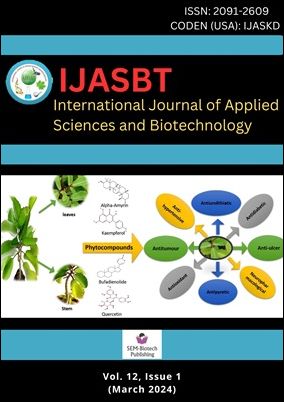Fabrication and Characterization of Non-Conventional Starch Based Biofilms Employing Different Plasticizers
DOI:
https://doi.org/10.3126/ijasbt.v12i1.64332Keywords:
Biomaterials, Biopolymers, Bioplastics, Agro waste management, Environmental sustainability, Ternary blend filmsAbstract
Increasing stress on environmental awareness has promoted the use of alternative strategies for common petrochemical based plastic sources to environmentally friendly biofilms and packaging materials. Food by products and underutilised indigenous plants sources are rich in biopolymers which can naturally decompose. The present study focusses on preparations of bioplastics from unconventional starch sources of litchi seed and churkha tuber as novel initiative to combat environmental pollution along with valorisation of undervalued plant sources and agrobased wastes. Ternary blend films of poly vinyl alcohol, starch, plasticizers like (glycerol, sorbitol, mannitol, propylene glycol, polyethylene glycol), citric acid prepared by casting technique produced best result. Comparative study of test samples (TH11, TH12, TH13, TH14 etc) with standardized thin films (TH1, TH2, TH3 etc.) showed variation in appearance, water activity, thickness, since the starch differ in their compositions, gelatinization and gelation time and temperature. High amylose containing litchi seed starch forms firm and more flexible films in comparison to low amylose containing churkha tuber starch. Maximum hygroscopicity was recorded in case of TH1 (77.4%) while thickness was maximum in case of TH12 (0.18 mm). Micro structural analysis clearly showed the nature of crosslinking between starch molecule and different plasticizers. The sensory analysis of food packed with the best among the formularized thin films showed mild change in taste while the other parameters remain same as normal. Better acceptability was in case of TH12 wrapped food rather than TH1. Thus, fabrication of biodegradable packaging is considered as the most sustainable alternative for food preservation.
Int. J. Appl. Sci. Biotechnol. Vol 12(1): 29-38.
Downloads
Downloads
Published
How to Cite
Issue
Section
License
Copyright (c) 2024 International Journal of Applied Sciences and Biotechnology

This work is licensed under a Creative Commons Attribution-NonCommercial 4.0 International License.




